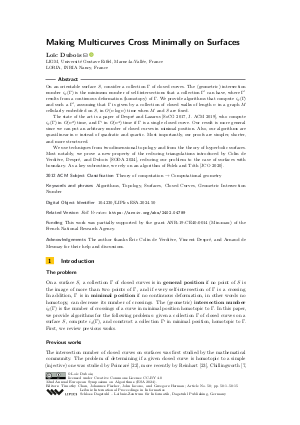Making Multicurves Cross Minimally on Surfaces
Author
Loïc Dubois 
-
Part of:
Volume:
32nd Annual European Symposium on Algorithms (ESA 2024)
Part of: Series: Leibniz International Proceedings in Informatics (LIPIcs)
Part of: Conference: European Symposium on Algorithms (ESA) - License:
 Creative Commons Attribution 4.0 International license
Creative Commons Attribution 4.0 International license
- Publication Date: 2024-09-23
File

PDF
LIPIcs.ESA.2024.50.pdf
- Filesize: 1.1 MB
- 15 pages
Document Identifiers
Related Versions
- Full Version https://arxiv.org/abs/2402.04789
Subject Classification
ACM Subject Classification
- Theory of computation → Computational geometry
Keywords
- Algorithms
- Topology
- Surfaces
- Closed Curves
- Geometric Intersection Number
Metrics
- Access Statistics
-
Total Accesses (updated on a weekly basis)
0PDF Downloads0Metadata Views
Abstract
On an orientable surface S, consider a collection Γ of closed curves. The (geometric) intersection number i_S(Γ) is the minimum number of self-intersections that a collection Γ' can have, where Γ' results from a continuous deformation (homotopy) of Γ. We provide algorithms that compute i_S(Γ) and such a Γ', assuming that Γ is given by a collection of closed walks of length n in a graph M cellularly embedded on S, in O(n log n) time when M and S are fixed. The state of the art is a paper of Despré and Lazarus [SoCG 2017, J. ACM 2019], who compute i_S(Γ) in O(n²) time, and Γ' in O(n⁴) time if Γ is a single closed curve. Our result is more general since we can put an arbitrary number of closed curves in minimal position. Also, our algorithms are quasi-linear in n instead of quadratic and quartic. Most importantly, our proofs are simpler, shorter, and more structured. We use techniques from two-dimensional topology and from the theory of hyperbolic surfaces. Most notably, we prove a new property of the reducing triangulations introduced by Colin de Verdière, Despré, and Dubois [SODA 2024], reducing our problem to the case of surfaces with boundary. As a key subroutine, we rely on an algorithm of Fulek and Tóth [JCO 2020].
Cite As Get BibTex
Loïc Dubois. Making Multicurves Cross Minimally on Surfaces. In 32nd Annual European Symposium on Algorithms (ESA 2024). Leibniz International Proceedings in Informatics (LIPIcs), Volume 308, pp. 50:1-50:15, Schloss Dagstuhl – Leibniz-Zentrum für Informatik (2024)
https://doi.org/10.4230/LIPIcs.ESA.2024.50
BibTex
@InProceedings{dubois:LIPIcs.ESA.2024.50,
author = {Dubois, Lo\"{i}c},
title = {{Making Multicurves Cross Minimally on Surfaces}},
booktitle = {32nd Annual European Symposium on Algorithms (ESA 2024)},
pages = {50:1--50:15},
series = {Leibniz International Proceedings in Informatics (LIPIcs)},
ISBN = {978-3-95977-338-6},
ISSN = {1868-8969},
year = {2024},
volume = {308},
editor = {Chan, Timothy and Fischer, Johannes and Iacono, John and Herman, Grzegorz},
publisher = {Schloss Dagstuhl -- Leibniz-Zentrum f{\"u}r Informatik},
address = {Dagstuhl, Germany},
URL = {https://drops.dagstuhl.de/entities/document/10.4230/LIPIcs.ESA.2024.50},
URN = {urn:nbn:de:0030-drops-211216},
doi = {10.4230/LIPIcs.ESA.2024.50},
annote = {Keywords: Algorithms, Topology, Surfaces, Closed Curves, Geometric Intersection Number}
}
Author Details
Funding
This work was partially supported by the grant ANR-19-CE40-0014 (Min-max) of the French National Research Agency.
Acknowledgements
The author thanks Éric Colin de Verdière, Vincent Despré, and Arnaud de Mesmay for their help and discussions.
References
-
Hugo A. Akitaya, Radoslav Fulek, and Csaba D. Tóth. Recognizing weak embeddings of graphs. ACM Transactions on Algorithms, 15(4):Article 50, 2019.

-
Mark A. Armstrong. Basic Topology. Springer New York, NY, 1983.

-
Joan S Birman and Caroline Series. An algorithm for simple curves on surfaces. Journal of the London Mathematical Society, 2(2):331-342, 1984.

-
J. E. Bresenham. Algorithm for computer control of a digital plotter. IBM Systems Journal, 4(1):25-30, 1965.

-
James W. Cannon, William J. Floyd, Richard Kenyon, and Walter R. Parry. Hyperbolic geometry. In Silvio Levi, editor, Flavors of geometry. Cambridge University Press, 1997.

-
Hsien-Chih Chang and Arnaud de Mesmay. Tightening curves on surfaces monotonically with applications. ACM Transactions on Algorithms, 18(4):1-32, 2022.

-
David R.J. Chillingworth. Simple closed curves on surfaces. Bulletin of the London Mathematical Society, 1(3):310-314, 1969.

-
David R.J. Chillingworth. Winding numbers on surfaces. II. Mathematische Annalen, 199(3):131-153, 1972.

-
Marshall Cohen and Martin Lustig. Paths of geodesics and geometric intersection numbers: I. In Combinatorial group theory and topology, volume 111 of Ann. of Math. Stud., pages 479-500. Princeton Univ. Press, 1987.

-
Éric Colin de Verdière, Vincent Despré, and Loïc Dubois. Untangling graphs on surfaces. In Proceedings of the 2024 Annual ACM-SIAM Symposium on Discrete Algorithms (SODA), pages 4909-4941, 2024.

- Pier Francesco Cortese, Giuseppe Di Battista, Maurizio Patrignani, and Maurizio Pizzonia. On embedding a cycle in a plane graph. Discrete Mathematics, 309(7):1856-1869, 2009. 13th International Symposium on Graph Drawing, 2005. URL: https://doi.org/10.1016/j.disc.2007.12.090.
-
Maurits de Graaf and Alexander Schrijver. Making curves minimally crossing by reidemeister moves. Journal of Combinatorial Theory, Series B, 70(1):134-156, 1997.

-
Vincent Despré and Francis Lazarus. Computing the geometric intersection number of curves. Journal of the ACM, 66(6):41:1-45:49, 2019.

-
David Eppstein. Dynamic generators of topologically embedded graphs. In Proceedings of the 14th Annual ACM-SIAM Symposium on Discrete Algorithms (SODA), pages 599-608, 2003.

-
Benson Farb and Dan Margalit. A primer on mapping class groups. Princeton university Press, 2012.

-
Radoslav Fulek and Csaba D Tóth. Crossing minimization in perturbed drawings. Journal of Combinatorial Optimization, 40(2):279-302, 2020.

-
Joel Hass and Peter Scott. Intersections of curves on surfaces. Israel Journal of Mathematics, 51(1-2):90-120, 1985.

-
Joel Hass and Peter Scott. Shortening curves on surfaces. Topology, 33(1):25-43, 1994.

-
Lutz Kettner. Using generic programming for designing a data structure for polyhedral surfaces. Computational Geometry: Theory and Applications, 13:65-90, 1999.

-
Francis Lazarus, Michel Pocchiola, Gert Vegter, and Anne Verroust. Computing a canonical polygonal schema of an orientable triangulated surface. In Proceedings of the 17th Annual Symposium on Computational Geometry (SOCG), pages 80-89. ACM, 2001.

-
Martin Lustig. Paths of geodesics and geometric intersection numbers: II. In Combinatorial group theory and topology, volume 111 of Ann. of Math. Stud., pages 501-543. Princeton Univ. Press, 1987.

-
Henri Poincaré. Cinquième complément à l'analysis situs. Rendiconti del Circolo Matematico di Palermo, 18(1):45-110, 1904.

-
Bruce L. Reinhart. Algorithms for Jordan curves on compact surfaces. Annals of Mathematics, pages 209-222, 1962.

